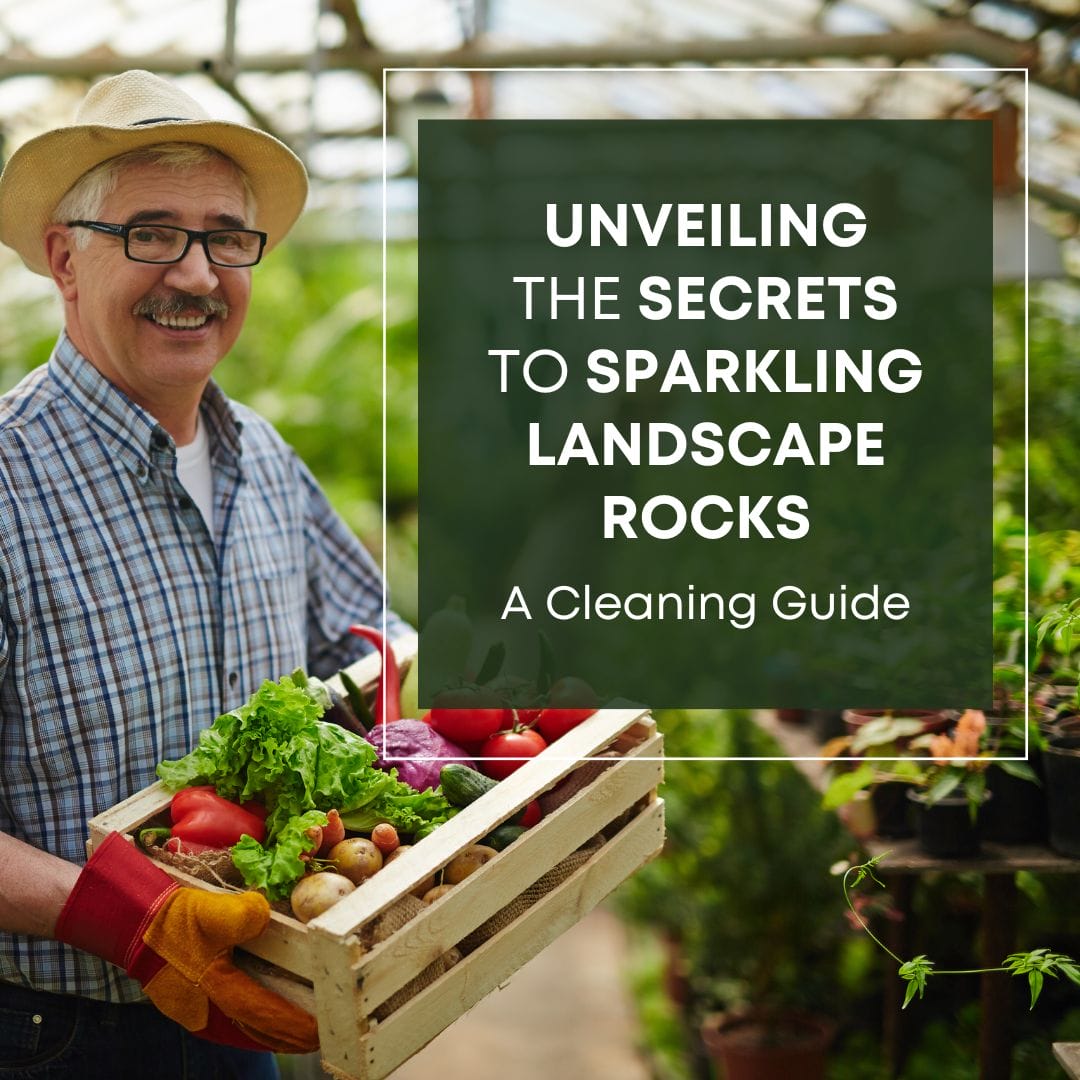Landscape rocks are gravel mulch, flagstone pavers, or landscape boulders. They last forever, are hard-wearing, and add natural style and beauty. Those nice-looking, perfectly placed landscape rocks may not look the same after a few years. Caked-on dirt, mud, moss, or bird droppings has changed it into an eyesore that once was an asset in your landscape. But with a little work, you can give the rocks a makeover they are in desperate need of.
These decorative rocks are low-maintenance, and you can go without caring about them for years. However, you might need to do some maintenance now and then to keep landscape rocks looking their best. If you are looking at your dirty landscaping rocks and wondering how to clean landscape rocks, here are some tips on how to clean landscape rocks and keep them looking fresh every year.
Why Should You Clean Landscape Rocks?
Landscape rocks accumulate debris, organic matter, and dirt between them over the years, similar to how pet odors can linger in carpets and fabrics. You should clean your landscaping rocks because:
Unpleasant Aesthetics
I don’t deny that algae and moss can add to the aesthetics in some settings. But mostly, they stain the surface and mar the overall aesthetic of the landscape. Regularly cleaning the rocks will prevent this situation and keep them pleasant to look at.
Hazardous
Mold, moss, or algae degrades the rock’s surface, posing a health hazard, which is a concern similar to ensuring the proper refinishing of bamboo flooring. It makes the rocks slippery and can be a haven for toxic mold spores. It becomes necessary to replace or wash the rocks at this stage.
Vegetation
Accumulating dirt provides favorable conditions for weeds and other unwanted plants to grow, similar to the considerations when discussing laminate flooring in a basement. If left unchecked, it can obscure the landscaping design and give it an unkempt look.
Uninvited Guests
The dry debris and leaves build it a comfortable home for pests like cockroaches, rats, and ants. You can reduce the build-up by running a leaf blower over the area, but you will have to perform intensive cleaning annually or bi-annually.
Things You Need To Clean Landscape Rocks
- Nylon scrub brush
- Dish soap
- Biodegradable cleaner
- Spray bottle
- Laundry detergent
- Baking soda or denture cleaner
- Hose
- 5-gallon bucket
- Power washer
- Bleach or white vinegar
- Old toothbrush
How to Clean Landscape Rocks
River rock or landscape stone might need cleaning every two years. You can do a few small things throughout the year to keep the landscaping rocks looking great and do the complete cleaning once every two years.
In between the thorough cleaning, you can:
- Pull out weeds
- Edge the lawn around gravel beds
- Clean up debris
- Blow fallen leaves out in the fall
- Add a pre-emergent weed killer to prevent new weed growth
Doing this will save you time over the long run for major cleaning. Deep cleaning is the best way to go if the landscape rocks become overwhelmed with dirt, weeds, and silt, much like installing laminate flooring in an RV requires thorough preparation and cleaning. It is time-consuming and tedious, including power washing, sifting, and replacing the rocks.
Landscape rocks can hold large amounts of organic matter, blown-in dirt, and other debris requiring periodic cleaning.
Steps to Clean Landscape Rocks
Get Rid of Loose Debris with a Leaf Blower
First, use a leaf blower to remove loose debris from the rocks, a process that can be as detailed as following a hardwood floor staining guide. The efficient way to do this is to blow it out of the crannies and nooks first. If you don’t have a blower, you can clear the debris with a broom.
Removing loose dirt or leaves before cleaning landscape rocks is essential because washing them with water would make a greater mess, a concept that aligns with the importance of choosing the right hardwood floor finish.
Start with Smaller Stones
You will have to sift the pebbles with a sieve that should have holes large enough for the debris to fall through but small enough to prevent bigger rocks. Sweep away the fallen debris and clean down the remaining rocks.
Use a garden brush or broom, water from a hose, and give the rocks a good scrub. Remove the stubborn, oily stains using a drop or two of dish soap.
Clean River Rock Landscaping
River rocks are too big to carry in a sieve, and their texture differs significantly from hand-scraped and smooth hardwood floors. Flood the rocks using a hose without a nozzle to let the water wash the debris out of the rocks. This washing works the best when the rocks are placed in a place that allows dirty water to drain away.
Remove Moss, Mold, or Fungus.
To remove fungus or mold, use white vinegar or bleach, ensuring you handle these substances as carefully as you would when using Swiffer on vinyl plank flooring. Make sure you wear gloves when you pour them over the rocks. Be careful that you avoid bleach or white vinegar getting on nearby plants.
If the rocks are still stained after rinsing them, fill the rock containers with water and add one part bleaching powder and two parts water to cover the rocks for the washing.
Pressure Washer to Clean Rocks
You can use a pressure washer to blast away dirt from large landscape rocks. However, keep it in a low-pressure setting to avoid chipping the rocks. If the dirt is not too stubborn, you can use a garden hose to clean the rocks.
Dish Detergent to Clean Rocks
Washing rocks with dish detergent is a good idea. It helps remove grease stains and washes away stubborn dirt. Make sure you rinse the rocks to avoid spots and marks from the soap.
Remove Organic Growth Safely
Moss, Mold, and Algae leave unsightly spots on the surfaces. But washing off the growth itself is not as easy as it sounds, much like understanding the intricacies of timeless wood floor patterns Consider deep cleaning processes with natural ingredients like bleach and vinegar to effectively remove organic growth.
How to Clean Smaller Landscaping Gravel or Stones?
Landscaping gravel or stones are low maintenance, versatile and affordable, similar to the advantages of LVT flooring. But they need washing over time to restore the aesthetic appeal, especially if they are light-toned.
You can clean it in between more intensive cleaning by rinsing it with a pressure washer hose on a low power setting.
You can dig up the gravel and sift out any loose debris for major cleaning using a metal hardware cloth. Then, put the stones in a wheelbarrow or bucket and fill it with water. Rinse them and drain the dirty water out. Drilling a drainage hole in the bottom of the bucket makes this job a lot easier.
How to Clean White Landscaping Stones?
For light-colored landscaping stones and gravel, sift them as mentioned above, then line up a wheelbarrow with a tarpaulin and put the stones and gravel into it before putting them in 50ml of bleach and 20 liters of water.
Leave them submerged for up to 24 hours and carefully drain the bleach and water mix. Then you can put the stones back in your garden.
How to Clean Boulder Landscape Rock?
Decorative boulder rocks are the easiest to clean. One of the reasons why you might want to clean the landscape boulders is lichens. But lichens do not damage stones or trees. They are a critical part of ecosystems. They are natural and can add character to your boulders.
If you still want to clean the boulder rocks, you can start by removing dirt using a broom and scrubbing them with a rag and warm water. Then rinse it to wash off mud with a garden hose.
If the boulder rocks have moss and algae, scrub them with white vinegar and a scrub brush. Then rinse them again with a garden hose.
Other Beneficial Tips On Cleaning Landscape Rocks
Deep cleaning once a year with bleach or vinegar should be sufficient to kill off moss or mold. Keep an eye on the recurrence in between the intensive cleaning. To make the deep cleaning more effective, follow these steps:
- Putting the rocks into a bucket makes inspecting every surface and edge easier. Mold hides under the underside, which can only be seen when you pick up the rocks. Taking out the rock will also dry out any moisture on it. This is especially useful for light-colored stones.
- Treat all the rocks and materials in the same way, or some will look lighter than others destroying the aesthetic.
- If you are going to use a pressure washer, make sure you remove smaller pebbles, gravel, and other stones to avoid them from scattering. The best way is to place them on a sieve to remove gravel and debris.
- Bleach works better on white rocks. Also, identify the type of stones as bleach can leave pockmarks on softer stones.
- An alternative to bleach is white vinegar and water in a ratio of 1:1. White vinegar works well on all types of stones and doesn’t degrade the rock surface.
- It doesn’t splash on your skin when pouring the mixture of bleach or white vinegar on the rocks.
- Leave the rocks soaking in the mixture for 20-30 minutes.
- Wear safety rubber gloves when using white vinegar or bleach.
- Do not dump the mixture on the plants.
- Remove the rocks one by one and rinse them off in a bucket. Or empty the bucket, refill it with clean water, and rinse the rocks.
- Make sure you wash the rocks well because the bleach or vinegar’s acidity can degrade the stone’s surface.
- Sweep the place where you will put the rocks to dry.
- When they are dried, put the rocks back in their positions and enjoy your clean and neat landscape.


